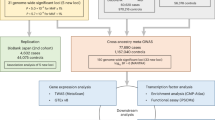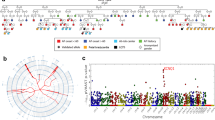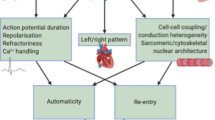Abstract
Atrial fibrillation is the most common cardiac arrhythmia and leads to stroke. To investigate genetic loci associated with atrial fibrillation in the Japanese population, we performed a genome-wide association study (GWAS) that included 8,180 atrial fibrillation cases and 28,612 controls with follow-up in an additional 3,120 cases and 125,064 controls. We replicated previously reported loci and identified six new loci, near the KCND3, PPFIA4, SLC1A4–CEP68, HAND2, NEBL and SH3PXD2A genes. Five of the six new loci were specifically associated with atrial fibrillation in the Japanese population after comparing our data to those from individuals of European ancestry, suggesting that there might be different genetic factors affecting susceptibility across ancestry groups. Our study discovered variants in the HAND2, KCND3 and NEBL genes, which are relevant to atrial fibrillation susceptibility. The involvement of PPFIA4 and SH3PXD2A in axon guidance also suggested a role in disease pathogenesis. Our findings may contribute to a better understanding of atrial fibrillation susceptibility and pathogenesis.
This is a preview of subscription content, access via your institution
Access options
Access Nature and 54 other Nature Portfolio journals
Get Nature+, our best-value online-access subscription
$29.99 / 30 days
cancel any time
Subscribe to this journal
Receive 12 print issues and online access
$209.00 per year
only $17.42 per issue
Buy this article
- Purchase on Springer Link
- Instant access to full article PDF
Prices may be subject to local taxes which are calculated during checkout

Similar content being viewed by others
References
Inoue, H. et al. Prevalence of atrial fibrillation in the general population of Japan: an analysis based on periodic health examination. Int. J. Cardiol. 137, 102–107 (2009).
Fox, C.S. et al. Parental atrial fibrillation as a risk factor for atrial fibrillation in offspring. J. Am. Med. Assoc. 291, 2851–2855 (2004).
Gudbjartsson, D.F. et al. Variants conferring risk of atrial fibrillation on chromosome 4q25. Nature 448, 353–357 (2007).
Benjamin, E.J. et al. Variants in ZFHX3 are associated with atrial fibrillation in individuals of European ancestry. Nat. Genet. 41, 879–881 (2009).
Ellinor, P.T. et al. Common variants in KCNN3 are associated with lone atrial fibrillation. Nat. Genet. 42, 240–244 (2010).
Ellinor, P.T. et al. Meta-analysis identifies six new susceptibility loci for atrial fibrillation. Nat. Genet. 44, 670–675 (2012).
Sinner, M.F. et al. Integrating genetic, transcriptional, and functional analyses to identify 5 novel genes for atrial fibrillation. Circulation 130, 1225–1235 (2014).
Dewland, T.A., Olgin, J.E., Vittinghoff, E. & Marcus, G.M. Incident atrial fibrillation among Asians, Hispanics, blacks, and whites. Circulation 128, 2470–2477 (2013).
Pe'er, I., Yelensky, R., Altshuler, D. & Daly, M.J. Estimation of the multiple testing burden for genomewide association studies of nearly all common variants. Genet. Epidemiol. 32, 381–385 (2008).
So, H.C., Gui, A.H., Cherny, S.S. & Sham, P.C. Evaluating the heritability explained by known susceptibility variants: a survey of ten complex diseases. Genet. Epidemiol. 35, 310–317 (2011).
JCS Joint Working Group. Guidelines for pharmacotherapy of atrial fibrillation (JCS 2013). Circ. J. 78, 1997–2021 (2014).
Zollner, S. & Pritchard, J.K. Overcoming the winner's curse: estimating penetrance parameters from case–control data. Am. J. Hum. Genet. 80, 605–615 (2007).
McFadden, D.G. et al. A GATA-dependent right ventricular enhancer controls dHAND transcription in the developing heart. Development 127, 5331–5341 (2000).
Morikawa, Y. & Cserjesi, P. Cardiac neural crest expression of Hand2 regulates outflow and second heart field development. Circ. Res. 103, 1422–1429 (2008).
Dunah, A.W. et al. LAR receptor protein tyrosine phosphatases in the development and maintenance of excitatory synapses. Nat. Neurosci. 8, 458–467 (2005).
Santiago-Medina, M., Gregus, K.A., Nichol, R.H., O'Toole, S.M. & Gomez, T.M. Regulation of ECM degradation and axon guidance by growth cone invadosomes. Development 142, 486–496 (2015).
Kirby, M.L. & Stewart, D.E. Neural crest origin of cardiac ganglion cells in the chick embryo: identification and extirpation. Dev. Biol. 97, 433–443 (1983).
Duarri, A. et al. Mutations in potassium channel kcnd3 cause spinocerebellar ataxia type 19. Ann. Neurol. 72, 870–880 (2012).
Duarri, A. et al. Spinocerebellar ataxia type 19/22 mutations alter heterocomplex Kv4.3 channel function and gating in a dominant manner. Cell. Mol. Life Sci. 72, 3387–3399 (2015).
Duarri, A. et al. The L450F mutation in KCND3 brings spinocerebellar ataxia and Brugada syndrome closer together. Neurogenetics 14, 257–258 (2013).
Lee, Y.C. et al. Mutations in KCND3 cause spinocerebellar ataxia type 22. Ann. Neurol. 72, 859–869 (2012).
Smets, K. et al. First de novo KCND3 mutation causes severe Kv4.3 channel dysfunction leading to early onset cerebellar ataxia, intellectual disability, oral apraxia and epilepsy. BMC Med. Genet. 16, 51 (2015).
Olesen, M.S. et al. A novel KCND3 gain-of-function mutation associated with early-onset of persistent lone atrial fibrillation. Cardiovasc. Res. 98, 488–495 (2013).
Bang, M.L. & Chen, J. Roles of nebulin family members in the heart. Circ. J. 79, 2081–2087 (2015).
Eulitz, S. et al. Identification of Xin-repeat proteins as novel ligands of the SH3 domains of nebulin and nebulette and analysis of their interaction during myofibril formation and remodeling. Mol. Biol. Cell 24, 3215–3226 (2013).
Moncman, C.L. & Wang, K. Targeted disruption of nebulette protein expression alters cardiac myofibril assembly and function. Exp. Cell Res. 273, 204–218 (2002).
Maiellaro-Rafferty, K. et al. Altered regional cardiac wall mechanics are associated with differential cardiomyocyte calcium handling due to nebulette mutations in preclinical inherited dilated cardiomyopathy. J. Mol. Cell. Cardiol. 60, 151–160 (2013).
Purevjav, E. et al. Nebulette mutations are associated with dilated cardiomyopathy and endocardial fibroelastosis. J. Am. Coll. Cardiol. 56, 1493–1502 (2010).
Lubitz, S.A. et al. Independent susceptibility markers for atrial fibrillation on chromosome 4q25. Circulation 122, 976–984 (2010).
Kuriyama, S. et al. The Tohoku Medical Megabank Project: design and mission. J. Epidemiol. 26, 493–511 (2016).
Freedman, M.L. et al. Assessing the impact of population stratification on genetic association studies. Nat. Genet. 36, 388–393 (2004).
Yang, J. et al. Genomic inflation factors under polygenic inheritance. Eur. J. Hum. Genet. 19, 807–812 (2011).
Segrè, A.V., Groop, L., Mootha, V.K., Daly, M.J. & Altshuler, D. Common inherited variation in mitochondrial genes is not enriched for associations with type 2 diabetes or related glycemic traits. PLoS Genet. 6, e1001058 (2010).
Acknowledgements
We express our heartfelt gratitude to all the participants in this study. We would like to express our gratefulness to the staff of TMM, J-MICC, JPHC and BBJ for their outstanding assistance. We extend our appreciation to N. Miyagawa and other members of the Laboratory for Statistical Analysis, RIKEN Center for Integrative Medical Sciences for their support. This study was in part supported by the Naito Foundation Natural Science Scholarship to T.T. This study was also funded by the BioBank Japan project and the Tohoku Medical Megabank project, which is supported by the Ministry of Education, Culture, Sports, Sciences and Technology Japan and the Japan Agency for Medical Research and Development. The JPHC Study has been supported by the National Cancer Research and Development Fund since 2010 and was supported by a Grant-in-Aid for Cancer Research from the Ministry of Health, Labour and Welfare of Japan from 1989 to 2010. The J-MICC Study was supported by Grants-in-Aid for Scientific Research for Priority Areas of Cancer (17015018) and Innovative Areas (221S0001) and the JSPS KAKENHI Grant (16H06277) from the Japan Ministry of Education, Science, Sports, Culture and Technology. The following research institutions participated in the study: Chiba Cancer Center, University of Shizuoka, Nagoya City University, Aichi Cancer Center, Nagoya University, Shiga University of Medical Science, Kyoto Prefectural University of Medicine, University of Tokushima, Kyushu University, Saga University and Kagoshima University. This work was supported by grants from the US National Institutes of Health to P.T.E. (1RO1HL092577, R01HL128914, K24HL105780). P.T.E. is also supported by an Established Investigator Award from the American Heart Association (13EIA14220013) and by the Fondation Leducq (14CVD01).
Author information
Authors and Affiliations
Consortia
Contributions
S.-K.L., K.I. and Y.K. wrote the manuscript. S.-K.L., A.T. and Y.K. conducted the data analyses. Y.E., K.O. and T.F. conducted replication genotyping, I.E.C., P.T.E. and the AFGen Consortium provided data from the AFGen Consortium. M.K. conducted SNP genotyping. Y.E., S.O., M.Y., M. Satoh, M. Sasaki, T.Y., M.I., S.T., K.T., M.N., K.W., H.T., T.F. and M.K. collected the samples. S.-K.L., A.T., K.I., Y.K. and T.T. designed the study.
Corresponding authors
Ethics declarations
Competing interests
The authors declare no competing financial interests.
Additional information
A full list of members and affiliations appears in the Supplementary Note.
Supplementary information
Supplementary Text and Figures
Supplementary Figures 1–5, Supplementary Tables 1, 2 and 7–11, and Supplementary Note (PDF 3606 kb)
Supplementary Table 3
Association studies after adjusting for the effect of diabetes. (XLSX 52 kb)
Supplementary Table 4
Association studies after adjusting for the effect of myocardial infarction. (XLSX 49 kb)
Supplementary Table 5
Association studies after adjusting for the effect of heart failure. (XLSX 53 kb)
Supplementary Table 6
Association of atrial fibrillation variants with other traits according to the GWAS catalog (12 December 2016). (XLSX 49 kb)
Rights and permissions
About this article
Cite this article
Low, SK., Takahashi, A., Ebana, Y. et al. Identification of six new genetic loci associated with atrial fibrillation in the Japanese population. Nat Genet 49, 953–958 (2017). https://doi.org/10.1038/ng.3842
Received:
Accepted:
Published:
Issue Date:
DOI: https://doi.org/10.1038/ng.3842
This article is cited by
-
Pathophysiology and clinical relevance of atrial myopathy
Basic Research in Cardiology (2024)
-
2024 European Heart Rhythm Association/Heart Rhythm Society/Asia Pacific Heart Rhythm Society/Latin American Heart Rhythm Society expert consensus statement on catheter and surgical ablation of atrial fibrillation
Journal of Interventional Cardiac Electrophysiology (2024)
-
Evaluating significance of European-associated index SNPs in the East Asian population for 31 complex phenotypes
BMC Genomics (2023)
-
Genomic approaches to identify and investigate genes associated with atrial fibrillation and heart failure susceptibility
Human Genomics (2023)
-
Outlining cardiac ion channel protein interactors and their signature in the human electrocardiogram
Nature Cardiovascular Research (2023)



